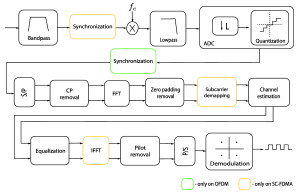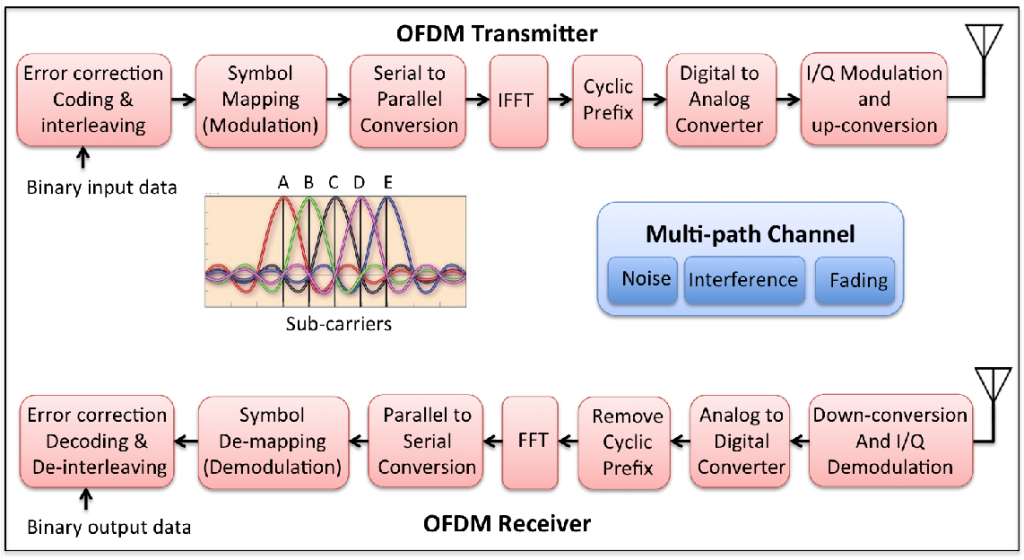The enigmatic and unpredictable world of wireless communication systems has witnessed a seismic shift with the introduction of OFDM technology. This revolutionary system has proven to be a game-changer, delivering unparalleled data rates and spectral efficiency. But as with any grand innovation, major challenges loom large.

Cellular networks have been grappling with implementing OFDM-based systems due to their complex nature. Advanced algorithms for channel estimation and synchronization techniques must be developed along with hardware design issues related to amplifier performance. These obstacles can leave one feeling bewildered.
Perhaps the most confounding issue facing OFDM-based systems is patent and copyright considerations. Companies must tread carefully during the design phase to ensure that they do not infringe on existing patents or copyrights, which may require licensing agreements with other companies.
Despite these labyrinthine hurdles, incorporating OFDM technology into wireless communication systems offers innumerable benefits such as improved system performance and spectral efficiency when compared to more traditional modulation schemes like AM or FM. To further enhance reliability by providing diversity in signal transmission paths, multiple-input multiple-output (MIMO) techniques can also be used in conjunction with OFDM.
The insatiable demand for higher data rates shows no signs of abating in wireless communication systems; thus we are likely to witness increased usage of OFDM technology within cellular networks and beyond. However, this necessitates ongoing research into new optimization techniques for channel estimation and synchronization alongside hardware improvements aimed at enhancing overall system performance while minimizing power consumption- leaving us all flummoxed about what’s coming next!
Implementation challenges faced in deploying OFDM-based systems in cellular networks
Contents
- 1 Implementation challenges faced in deploying OFDM-based systems in cellular networks
- 2 Challenges in optimizing channel estimation and synchronization techniques for OFDM signals
- 3 Patent and copyright considerations in OFDM implementation
- 4 Implementation issues related to hardware and amplifier design for OFDM-based systems
- 5 Challenges in improving system performance and spectral efficiency using OFDM techniques
- 6 Considerations for implementing MIMO and diversity schemes in OFDM systems
- 7 Future trends and evolution of OFDM technology in the context of and beyond.
The implementation of OFDM-based systems in cellular networks poses several challenges that must be addressed. One significant hurdle is the need for effective channel estimation and synchronization techniques. The use of orthogonal subcarriers means that even slight deviations from perfect synchronization can result in inter-carrier interference (ICI), significantly decreasing system performance. To surmount this obstacle, the IEEE 802.11a/g standard employs pilot symbols to estimate channel response and synchronize receivers.

Another challenge associated with implementing OFDM systems pertains to hardware design – specifically, power amplifiers (PA). Given its high peak-to-average power ratio (PAPR), OFDM signals necessitate PAs with robust linearity and efficiency, which can be both costly and complex to implement. Researchers have thus endeavored to explore alternative PA architectures such as envelope tracking or digital predistortion techniques that enhance both linearity and efficiency.
Finally, copyright considerations are also crucial when it comes to incorporating OFDM technology into wireless communication systems. Various patents exist around distinct aspects of OFDM technology ranging from signal processing algorithms, modulation schemes, all the way up to hardware designs themselves! As such, it’s vital for designers of an OFDM system first to ensure their implementation won’t infringe on existing patents or copyrights before deployment into a network environment; otherwise they’ll face legal repercussions down the road!
Challenges in optimizing channel estimation and synchronization techniques for OFDM signals
The optimization of channel estimation and synchronization techniques for OFDM signals is an enigmatic challenge in the field of wireless communication systems. OFDM, also known as orthogonal frequency division multiplexing, is a remarkable digital multiplexing scheme that discretizes available bandwidth into multiple subcarriers to enable simultaneous data transmission. However, achieving high system performance and spectral efficiency necessitates accurate channel estimation and synchronization.
To address this perplexity, various algorithms have been proposed such as pilot-based methods, blind approaches, and joint estimation schemes. Pilot-based methods involve inserting known symbols into the transmitted signal to estimate the channel response accurately at the receiver end. Blind approaches utilize statistical properties of the received signal to estimate channels without any additional information while joint estimation schemes combine both pilot-based and blind approaches to improve accuracy further.
Synchronization refers to aligning transmitter and receiver clocks so that they can operate on the same frequency with precise timing control required due to its narrowband nature. Timing errors can cause inter-symbol interference (ISI) between adjacent subcarriers leading to reduced system capacity or even complete loss of information transmission capability requiring advanced MIMO diversity schemes designed specifically for mitigating ISI effects caused by imperfect clock synchronization between transmitter/receiver pairs operating on different frequencies/timing offsets within an RF spectrum band allocated by regulators worldwide today! To address this burstiness issue, hardware-assisted processing techniques like FFT (Fast Fourier Transform)-based synchronization have been developed along with advanced MIMO diversity schemes which help maximize channel capacity while minimizing ISI effects caused by imperfect synchronization.
In conclusion, optimizing channel estimation and synchronization techniques for OFDM signals involves developing efficient algorithms that work seamlessly with hardware devices used in wireless communication systems while maximizing system capacity through advanced MIMO diversity schemes designed specifically for mitigating ISI effects caused by imperfect clock synchronization between transmitter/receiver pairs operating on different frequencies/timing offsets within an RF spectrum band allocated by regulators worldwide today!
Patent and copyright considerations in OFDM implementation
The implementation of OFDM-based systems in telecommunications is a perplexing task that demands close attention to patent and copyright considerations. The intricacies involved with the complex modulation scheme of OFDM techniques lead to potential coupling with other signals in the system, making it challenging to ensure infringement-free usage. As such, thorough research must be performed before utilizing novel techniques.
But intellectual property concerns aren’t the only hurdles faced when implementing OFDM-based systems. Hardware and amplifier design issues must also be taken into account for optimal performance. Synchronization and channel estimation techniques require meticulous attention as even small errors can result in significant signal quality degradation; thus, efficient algorithms are necessary.
Deploying OFDM-based systems within cellular networks poses further challenges – improving system performance and spectral efficiency while maintaining compatibility with existing infrastructure requires burstiness at every step. One way of achieving this goal is by introducing MIMO and diversity schemes within network architecture layers, which help reduce interference between different channels but necessitate careful optimization of parameters like antenna spacing and power allocation.
The intricacies of implementing OFDM-based systems are multifaceted, with one of the main challenges being the design of hardware and amplifiers that can handle the complex signal processing required for this technology. The use of high-performance digital signal processors (DSPs) is crucial to modulate and demodulate discrete subcarriers within an OFDM signal. Additionally, ensuring that amplifiers possess sufficient power output to transmit signals over long distances without distortion or interference is paramount.
Another critical consideration when designing OFDM hardware lies in exploiting its unique spectral characteristics. Due to its utilization of multiple closely spaced subcarriers, it may prove more resilient against narrowband interference than other wireless systems. Nonetheless, frequency planning and channel allocation require meticulous attention to prevent spectrum congestion from occurring.
In recent years, hybrid fiber-wireless networks have become increasingly prevalent by merging wired infrastructure with wireless access points. Within such networks, OFDM acts as a key player in providing high-speed wireless connectivity over short distances while simultaneously enabling data transmission via fiber optic cables across greater ranges. To facilitate seamless integration between these two technologies, designers must give careful consideration towards issues like network synchronization and system performance optimization for maximum spectral efficiency.
Challenges in improving system performance and spectral efficiency using OFDM techniques
The optimization of the fast Fourier transform (FFT) algorithm poses a perplexing challenge in improving system performance and spectral efficiency through OFDM techniques. The FFT component is indispensable for transforming signals from the time domain to frequency domain, but implementing it efficiently demands colossal computational resources that can impede bandwidth and data transmission rates.
In addition to this, curtailing peak-to-average power ratio (PAPR) remains an elusive feat in augmenting system performance via OFDM techniques. PAPR creates distortion in digital signals culminating into detection errors. Despite proposed solutions such as clipping, filtering or coding methods, these remedies frequently incur a cost of reduced spectral efficiency or increased complexity.
Improving the feasibility of deploying OFDM-based systems necessitates meticulous consideration of hardware design and amplifier selection. Selecting optimal components that exhibit linearity, noise figure, and dynamic range are pivotal factors for achieving impeccable system performance. Furthermore, power amplifiers require careful evaluation since they play an integral role in transmitting high-power signals with minimal distortion while maintaining superior energy efficiency.
Considerations for implementing MIMO and diversity schemes in OFDM systems
The impact of implementing MIMO and diversity schemes in OFDM systems on system performance must be carefully considered. While these techniques can enhance throughput and reliability by simultaneously transmitting and receiving signals through multiple antennas, they also demand more intricate signal processing methods that bump up system complexity and cost.
Furthermore, to deploy these schemes in mobile communication systems like 4G networks using time- or frequency-division multiplexing requires meticulous parameter tuning at the physical layer to ensure optimal performance while mitigating interference between users. But wait, there’s more!
Hardware design considerations such as selecting the right amplifier are critical for achieving high-speed communications due to the unique characteristics of OFDM signals. Additionally, deploying multiple antennas demands cautious antenna placement and design to minimize interference between them – a mind-bending task.
Overall, successfully implementing MIMO and diversity schemes in OFDM systems necessitates an all-encompassing understanding of theoretical concepts coupled with practical considerations related to signal processing, hardware design, and network deployment that will make your head spin!
Future trends and evolution of OFDM technology in the context of and beyond.
The ongoing evolution of OFDM technology is a perplexing matter, with its future being shrouded in burstiness. One area that has garnered considerable emphasis is the use of multicarrier techniques to enhance spectral efficiency by transmitting multiple carriers simultaneously. This paradigm shift towards multi-carrier modulation schemes such as orthogonal frequency-division multiplexing (OFDM) can already be observed in wireless communication systems like LTE networks.
Despite this promising trend, there exists a pressing need for more efficient channel estimation and synchronization techniques on the receiver side to improve system performance. However, amplifiers pose a significant challenge due to their susceptibility to distortion caused by high peak-to-average power ratios inherent in OFDM signals. As hardware and amplifier systems are designed for OFDM-based applications, meticulous consideration must be given.
Moreover, patent and copyright issues related to implementation loom large as future trends in OFDM technology unfold. Corporations must ensure they steer clear of existing patents or copyrights while developing new products or services based on this ingenious innovation. Henceforth, extensive research should precede any implementation of an OFDM-based system to avoid legal challenges down the line – bursting with complexities!


